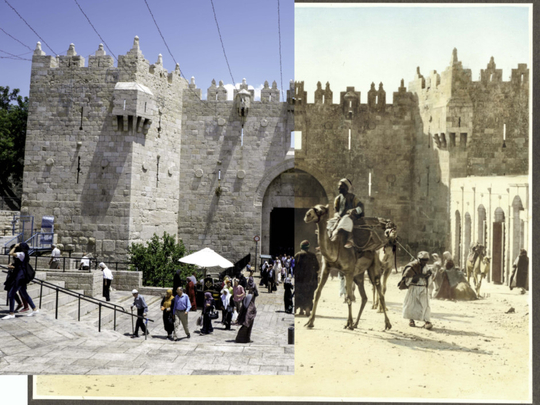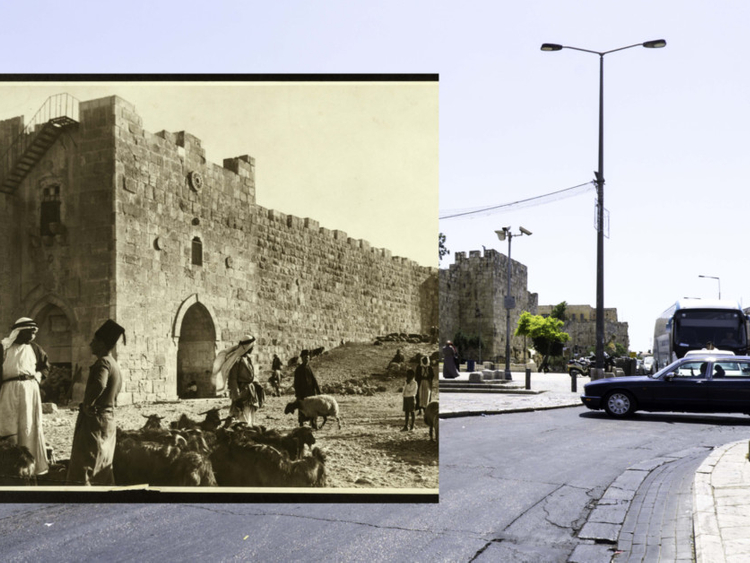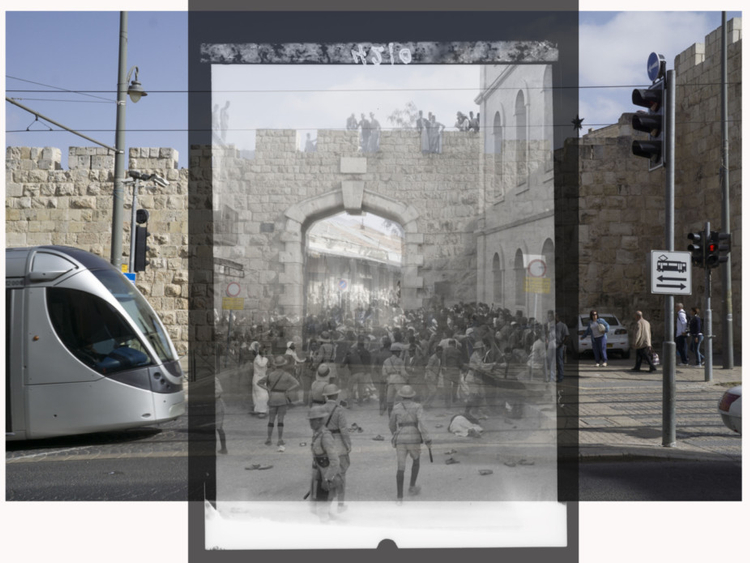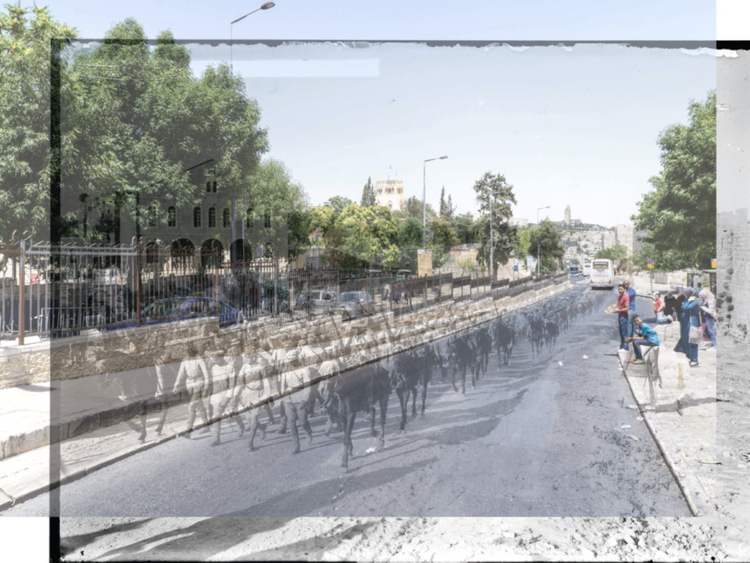
The famed old city of occupied Jerusalem is considered by many to be the most spiritual place on earth whereas others perceive it as the most disputed piece of real estate. For me, it continues to offer delightful surprises whenever I stroll on its narrow cobblestone streets. Now, a photographic exhibition by Jack Persekian exposes 100 years of Jerusalem’s layers of tumultuous history at Gallery Anadiel. And the unique aspect of the exhibition is that it brings together photographs from the 19th century of the city superimposed with photographs taken today in the same location.
To Persekian, the city is “an oxymoron, chock-full of contradictions and schizophrenic realities which we embrace in this seemingly blessed, but so easily deadly, potent formula of persistent animosity and violence. So far, no leader, political body or group of people, truly caring and genuinely concerned for the fate of the city, have been able to make a breakthrough on the political stalemate, or simply bring the various communities living here closer together.”
Persekian explains how the whole concept of the photographic exhibition came about.
“It started last year at the Albright Institute for Archeological Research. They invited me to do a project in their garden, it was a carte blanche invitation, which served as stimuli and intrigued me to do an archeological dig, using photography as a medium, to see layers of history through looking at old photographs that are present in the old city and that evoke sentimentality and nostalgia in Palestinians.”
“I wanted to see how we can see them in today’s eyes, enabling us to look beyond sentimental, nostalgic value of pictures and try to read what had driven those changes, compare areas of change developments and ask the questions of where and why. And at the back of my mind I was aware of the fact that is the 100th anniversary of the Balfour Declaration and the pictures were taken during that period of dramatic change, documenting the fall of the Ottoman Empire and beginning of the British Mandate. It was also appropriate to look at this period as it marks 70th anniversary of the Nakba and 50th anniversary of the 1967 War.”
Persekian decided to create an interactive, engaging and entertaining outdoor photographic exhibition in the garden of the Albright Institute in East Jerusalem.
“I was tired of exhibitions where art is talking to itself, so I started producing work by looking at old pictures, where the photographer was standing taking them, looked around to find the spots and it generated amazing passion as I rediscovered the old city, its geography, topography and understood the point of view the photographer had back then, namely the preconceived images constructed in his mind and how it affected the angle, framing and timing of appearance of people, lifestyle and all the different visual elements that defined his identity.”
Persekian was driven by a passion as he had to figure out a technique and method to pass onto viewers and to accord them the liberty to delve and uncover issues he was thinking about.
“Even after shooting the new pictures and working on a computer to align them perfectly with the old pictures, I had to do something in analogue instead of today’s digital trend. I went back to print new images on transparencies.”
The unique aspect of Persekian’s photographic art is the process of laying them over each other, allowing the viewer to flip images, move between old and new, compare and think about it.
“Superimposing an additional layer, a photograph taken today of the same location, over that taken by photographers some 100 years ago, shot from the same spot and angle, moves us between two distinctive times. It allows us to study the changes that occurred, compare the various times, align the physical transformations with the events that took place in the city and around the region during the last century, and deduce from these observations all the agendas at play, then, now, and still to come.”
The photographic pairs reveal conspicuously the sprawl of urban development that has come to dominate the horizon and much of the landscape in the West of the occupied city, and the lack of such development on the East side.
Control and discrimination
In his work, Persekian captures the epochs encompassed by the two layers (the pre-Israeli East and the post-Israeli West) and their juxtaposition help to comprehend how sustained systems of control and discrimination manage to create two very distinct and contrasting realities side by side, or perhaps level upon level.
“We can also see how politics controls and direct demography and instrumentalises everything at its disposal to empower one side, and disadvantage and undermine the other.”
They were exhibited in the garden of the Albright Institute in Salahuddin Street for two weeks last year and it was considered to be one of the most interesting and engaging exhibition in the sense of interaction, involvement of the audience in working with the pieces, opening them and asking questions about them.
“It was visible from the street and people walking outside were attracted to it and made to enter and view it,” he says. “It moved historical images from nostalgic realm to documents and enable people to read and delve into details. The juxtaposition overlaying present over the past brought life and meaning to buildings you can see, streets and the whole cityscape.”
Anadiel Gallery, Persekian points out, is open, causal, not an austere art gallery and with the light emanating from the boxes housing the photographs, it creates the attraction, which brings in tourists and even many Israelis.
Persekian says the exhibition is very popular with Palestinian children who come out of school and on their way home, stop over at the gallery to play with the photographs and, in doing so, it becomes meaningful as well as it all makes sense to them. This adds a sense of satisfaction to his efforts.
“We cannot know what the future holds for us Jerusalemites and for the city, but if things are left to the powers now in control it will surely embolden those disparities,” he says. “The work is an attempt to encourage people, especially Jerusalemites, to reassess their relation to the city, re-examine it carefully, indulge in its details and love it — not for what it was and what it symbolises — but for what it can be. As Miles van der Rohe put it so eloquently, ‘God is in the details’.”
I leave Anadiel Gallery knowing that a Palestinian has figured out the usage of old photographs by turning them into an art form. This is a way of keeping alive the hopes and aspirations of an occupied people and that is the magic of the old city of occupied Jerusalem, which never fails to amaze me.
Rafique Gangat, author of Bending the Rules, is based in Occupied Jerusalem.
















